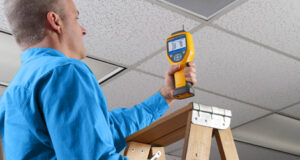Mold Removal in Dorval
So many people in Dorval who call Mold Busters do so out of fear of the mold in their homes. Today is the ideal time to engage mold specialists to determine whether you require mold removal Dorval because it’s a developing worry! It’s crucial to have professionals conduct testing to ensure the mold is under control because heritage buildings in particular are prone to infestation. It’s time for a significant adjustment if dangerous mold spores can be detected in the air. It’s also time for a change if there are noticeable particulates in the air.
Mold Detection Ways in Dorval
Inspection is crucial because it teaches you about and clarifies the situation you’re in. Both mold and asbestos have microscopic effects on you, which you may not be aware of until it is too late.
- Colors
- Odors
- Texture
- Patterns
How to Get Rid of Mold in Your Home
It can be scary to discover those dark mold areas in your basement or shower. Fortunately, a tiny quantity usually won’t make you sick, but understanding how to remove and avoid mold can stop it from becoming a major problem. Mold can still develop in undesirable locations despite your best efforts, so it’s important to keep your home’s rooms, such as the bathroom, dry and cool.

Everything you need to know about dealing with a mold situation is provided below.
Mold Can Lead to Disease
Mold can make you sick by dispersing spores that can lead to asthma episodes and other respiratory problems. Extremely poisonous black mold is possible. Due to the ease with which spores can spread throughout the building through HVAC systems and ambient air currents, a mold problem in one room can quickly become a problem for the entire structure. Our licensed mold inspectors can assist you in identifying the source of mold growth in your residence or place of business through skilled mold testing.
Find Trustworthy Mold Testing In Dorval
After the initial evaluation, our technician will typically suggest a mold test. We provide two different test types:
- Sample of a surface for mold
- Testing for mold in non-viable air
By using a tape, swab, or bulk sample, surface sampling can identify whether a surface is contaminated with mold. For instance, a surface sample will confirm or deny if a black spot on your ceiling is a mold with a simple yes or no. This kind of testing is typically simple and provides immediate findings. However, it does not offer quantitative data regarding your IAQ.
In contrast, a non-viable air test for mold will involve our specialist taking a sample of the air and sending it to a recognized laboratory for microbiological analysis. Important, more thorough information regarding your IAQ is revealed by lab results, including whether or not mold is present, the species present, and the quantity of mold spores in the air. Not all collections of black patches or musty smells are mold. Therefore, it’s wise to schedule a test before drawing any judgments.
What are the finest mold removal products?
No matter the task, these are the mold removers that we prefer.
- Bleach made of chlorine
- CLR Bath and Kitchen Cleaner
- Mold and mildew remover Clorox
- Mold and mildew remover Clorox
What to do if mold grows on shower tile and grout?
Due to the warm, moist environment that makes shower tile and grouts a prime breeding ground for mold, it can be challenging to keep this area mold-free. Smaller mold growths, however, can be eliminated with a grout cleaner. A mold remover, or a bleach and water mixture. Spray the grout, let it soak in, and then rinse. Some situations don’t require scrubbing: In our studies spray eliminated 99.9% of the bacteria and germs associated with mold and mildew in just five minutes.
How to clean shower liners and curtains of mold
A mold and mildew spray suitable for plastic, can be used to get rid of the mold if your shower curtain or liner is made of plastic. Spray on, wait until the spots are gone, and then rinse.
Another solution is to wash your plastic liner in the washing machine using warm water, bleach, and the delicate cycle. If the shower curtain is made of fabric, it is preferable to wash it at the warmest temperature recommended on the care label.
How to get rid of mold on ceilings and walls
The bad news is that it’s preferable to replace a surface that is extremely porous, like a ceiling tile. The good news is that, if you act quickly, mold can be stopped before it has a chance to spread further on sheetrock or plaster walls, ceilings, or other surfaces. This is how:
- Use a sponge or brush to thoroughly clean the surface with detergent and water before allowing it to dry completely.
- Add a solution of water and bleach after that: Mix one gallon of warm water with 1/4 cup of chlorine bleach. Apply the water-bleach solution to the spots with a sponge or brush while wearing rubber gloves.
- Then clean, rinse, and let air dry after five minutes.
How to remove mold from fabric
If left unattended for a long time, those wet towels or sports clothes can create an environment where mold can grow. Here’s how to get rid of mold if you notice it on certain textile items:
- To stop mold spores from entering your home, take the item outside and brush off any excess mold.
- If the fabric can be washed in a machine, rub in liquid detergent and wash it on the highest heat setting while using chlorine bleach or another type of bleach as directed in the care instructions.
- If the cloth cannot be machine washed, the mold can be removed by dry cleaning or hand washing.
Removing mold from wood
If there is inadequate ventilation in rooms like the kitchen, where there is more humidity from cooking or running the dishwasher, you can see mold growing on your wood cabinets. If the air is stagnant and humid, mold can also develop on wooden furniture and paneling. The steps listed below should be followed to remove mold from wood furniture, cabinets, or paneling:
- Vacuum the loose spores using a HEPA-filtered vacuum and the soft brush attachment.
- After that, combine a few drops of dish detergent, such as Dawn Platinum, with a gallon of water, and apply the mixture with a rag. To get rid of the mold, dampen the surface but don’t soak it.
- Follow up by wiping the area dry with a towel that has been dipped in clear water, and wrung out well. Do not leave the wood wet for an extended period of time as this could harm the finish.
